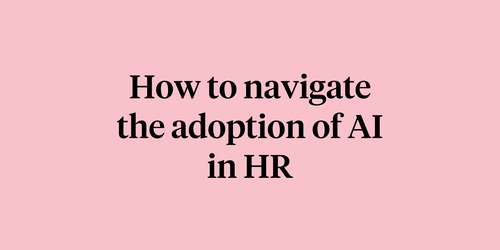
Stay interviews: Your key to retaining top performers

If only there was something you could do to make sure that your best employees won't leave your company... Oh wait — That’s what the stay interview is for.
Stay interviews are similar to an exit interview, except they are conversations with current employees who either aren’t planning to leave, or haven’t announced their intentions to leave yet. These conversations aim to understand the secret sauce to employee retention, or what an individual loves about working at your company, and what your business needs to change in order to keep them engaged and retained.
In this article, we dive into what stay interviews are, how you can use them at your organization to improve employee retention, and how to conduct these conversations step-by-step
What are stay interviews?
Stay interviews, or retention interviews, are 1-on-1 conversations with current employees about why they like working at your company and what they would change about the business, team, or role if they could. These conversations can also be used to assess an individual’s flight risk level, which can help your business anticipate hiring needs or jumpstart succession planning.
While these conversations will cover many of the same topics as exit interviews, one key difference between the two lies in who conducts the conversations. For exit interviews, HR teams usually take the reigns and speak with departing employees. For a stay interview, an individual’s direct manager or skip-level manager is usually the main driver of the conversation.
This distinction is tied to the goal of each of these conversations. During an exit interview, HR teams want to understand if there are any underlying issues they should be aware of that could be pushing other employees to leave as well. Stay interviews, on the other hand, try to gather information on how to improve the employee experience for one specific individual. As managers have the most control over an individual’s day-to-day experience at your company, it only makes sense for them to play a larger role in these employee retention conversations.
| Stay interview | Exit interview | |
| Interviewee | A top-performing employee | A departing employee |
| Interviewer | The employee’s manager or skip-level manager | An HR representative |
| Goal | Discover how to improve the employee experience for this specific employee and keep them around longer | Identify any underlying company, team, and role issues that could push other individuals to leave |
How do stay interviews help?
Not quite convinced stay interviews are right for your business? There are more than a few benefits to having these strategic conversations with your top-performing employees, including the ability to:
- Identify problems: Stay interviews are an effective way to collect employee feedback and discover what aspects of your employee experience could be pushing your employees to leave. For example, if inefficient processes, poor management, or lack of growth opportunities are making your employees unhappy, identifying these issues and taking action to fix them can help you retain top talent.
- Find solutions: Armed with this data, you can take action to fix these factors, improve the employee experience, and ensure your employees have a long healthy career at your organization.
-
Build trust and loyalty: Stay interviews show your employees that you care about their experience and want them to have a long, successful career with your company.
But be careful and intentional – while these retention conversations can be good for morale, that trust can be broken if you don’t take action based on these conversations. Taking immediate action on an employee’s feedback and continuing to update them on the progress of more long-term changes can maintain the momentum of your conversation and ensure your top talent stays happy. - Retain top talent: Stay interviews can be used to target your most valuable employees. Knowing how to keep them happy and taking action to fulfill their needs improves the likelihood that they will stay with your business for longer.
While most stay interview findings will most immediately impact your ability to make one individual happy, like giving one employee new responsibilities or stretch projects in their interest areas, some topics of discussion that pop up in these conversations can help you improve the employee experience for all your workers, like realizing you need to offer more professional growth opportunities or secure additional headcount to improve work-life balance for the team. Stay interviews are just one way to listen to your employees, but it’s helpful to also regularly survey your teams to understand how morale is changing and identify areas where your business can improve.
How to lead a stay interview?
If you’re ready to kick off a stay interview of your own, look no further. Here’s a step-by-step guide to scheduling and conducting a stay interview with one of your top-performing employees.
1.) Decide who will conduct the interview
While these conversations can be run by HR, they’re often more effective when led by an employee’s direct or skip-level manager. Consider choosing the individual the employee is closest with, as the employee might be more forthcoming with their feedback if they trust the meeting organizer.
2.) Identify and reach out to employees
These conversations shouldn’t be conducted on the fly – they need to be planned and private. Inform your employee of the purpose of your conversation, schedule a formal 1-on-1 meeting or call at a convenient time for them, and share stay interview questions upfront so they have time to formulate their thoughts ahead of time. If you aren’t sure when to schedule one of these conversations, a popular milestone is 90 days after a new hire starts. However, you can schedule one anytime you feel the need.
3.) Ask questions
Now, it’s time to sit down and conduct the stay interview. To help you get the most out of the discussion, we’ve put together a list of our favorite stay interview questions below.
Culture Amp’s top stay interview questions:
- What do you like most about working here?
- What do you like least?
- If you could change one thing about your team what would it be?
- If you could change one thing about our company, what would it be?
- Do you feel valued at work? Why or why not?
- Do you feel your work is properly recognized at our company? Why or why not?
- Do you feel the company is invested in your professional growth? Why or why not?
- How would you rate your work-life balance?
- What do you want to be doing that you aren't currently doing?
- What are the three most important things you would like to accomplish right now?
- What do you need that's preventing you from reaching those goals?
- How can we best support you to achieve those goals?
Don’t feel like you have to get through all of these questions during your conversation. You should feed off your employee’s responses and take the conversation where they want it to go
4.) Listen
While you can certainly ask follow-up questions and try to understand the “why” behind their answers, make sure you’re not commandeering the conversation. Once you ask a question, be quiet and listen – your employee should be the one doing the majority of the talking. Take detailed notes or record the conversation if you have your employee’s permission, so you can revisit their responses as needed.
5.) Take action
Next is the most labor-intensive part of stay interviews: taking action. For managers, this might be working with that individual employee to find ways to keep them engaged, like encouraging them to take paid time off and creating opportunities to adopt a flexible work schedule, work with cross-functional teams, or take on new projects in areas of interest. Be sure to circle back with your employee around any next steps you discussed during your conversation to keep them updated on your progress and remind them their professional growth is still top of mind for you.
6.) Predict turnover
Lastly, it’s time to document these conversations in a spreadsheet and rank an employee’s likelihood of leaving your business. While you can use whatever ranking system you want, many organizations adopt a green, yellow, and red system. An employee who receives a green rating seems like they are going to stay at least a year, a yellow individual might stay 6-12 months, while a red employee is very unhappy and likely looking for other opportunities. Based on these ratings, you can track flight risks and start succession planning.
You can also use this spreadsheet to measure the impact of your actions by reinterviewing these employees later in the year to see if their ranking has changed. For example, if an employee was ranked as a flight risk due to poor work-life balance, then it could be good to re-interview this same employee 6 months later after another individual was added to their team to help lighten their workload. Reinterviewing allows you to track if this change brought about an improvement that pushed the employee into the yellow or even green. This can help you prove the effectiveness of your stay interviews and show you’re actively working to improve employee retention.
Stay interviews: Your secret weapon for retaining top talent
The best way to build an exceptional employee experience is to listen to your employees. Stay interviews are just another way to connect with your talent, hear their concerns, and take action to build a better workplace where your employees can develop a lengthy career.
Looking for other ways to reduce employee turnover? Learn how to predict attrition, boost retention, and help your people thrive with Culture Amp.



